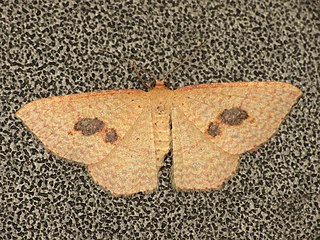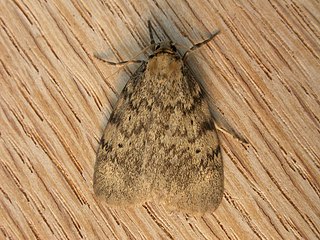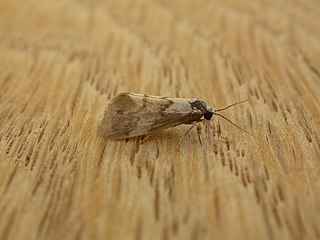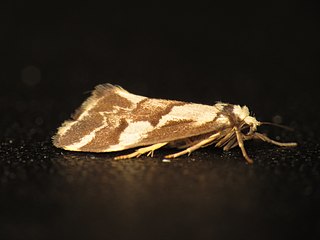Related Research Articles

Halone is a genus of moths in the subfamily Arctiinae from southern Asia and Australia. The genus was erected by Francis Walker in 1854.
Parelictis is a monotypic moth genus in the subfamily Arctiinae. Its only species, Parelictis saleuta, the mottled footman, has been recorded from the Australian states of New South Wales and Victoria. Both the genus and species were first described by Edward Meyrick in 1886.

Philenora is a genus of moths in the subfamily Arctiinae. The genus was erected by Rudolph Rosenstock in 1885.

Philenora elegans is a moth of the subfamily Arctiinae first described by Arthur Gardiner Butler in 1877. It is found in Australia.
Stenarcha is a monotypic moth genus in the subfamily Arctiinae erected by George Hampson in 1900. Its single species, Stenarcha stenopa, was first described by Edward Meyrick in 1886. It is found in the southern part of the Australian state of Western Australia.

Epicyme is a monotypic moth genus in the family Geometridae described by Edward Meyrick in 1885. Its only species, Epicyme rubropunctaria, the red-spotted delicate, described by Edward Doubleday in 1843, is found in New Zealand, the Australian Capital Territory, Tasmania and Victoria.

Hectobrocha adoxa, the unadorned footman, is a species of moth of the subfamily Arctiinae first described by Edward Meyrick in 1886. It is known from the Australian states of New South Wales and Victoria.

Philenora malthaca is a moth of the subfamily Arctiinae first described by Turner in 1944. It is known in Australia from the south-east coastal regions of New South Wales. There is a single record from Dromana in Victoria.
Hesychopa chionora, the white footman, is a moth of the subfamily Arctiinae. It was described by Edward Meyrick in 1886. It is found in the Australian states of Victoria, Queensland and New South Wales.
Damias procrena, the procrena footman, is a moth of the family Erebidae. The species was first described by Edward Meyrick in 1886. It is found in the Australian states of Victoria and Tasmania.
Halone ophiodes, the cryptic halone, is a moth of the subfamily Arctiinae. It was described by Edward Meyrick in 1886. It is found in Australia.
Hectobrocha pentacyma, the five-banded footman, is a moth of the subfamily Arctiinae. It was described by Edward Meyrick in 1886. It is found in the Australian states of Queensland, New South Wales and Victoria.
Heterallactis euchrysa is a moth of the family Erebidae. It was described by Edward Meyrick in 1886. It is found in the Australian states of Queensland and New South Wales.
Philenora cataplex is a moth in the subfamily Arctiinae. It was described by Turner in 1940. It is found in Australia.

Philenora chionastis is a moth in the subfamily Arctiinae. It was described by Edward Meyrick in 1886. It is found in the Australian states of Queensland and New South Wales.
Philenora placochrysa is a moth in the subfamily Arctiinae. It was described by Turner in 1899. It is found in Queensland, Australia.
Philenora pteridopola is a moth in the subfamily Arctiinae. It was described by Turner in 1922. It is found in Australia.
Philenora lunata is a moth in the subfamily Arctiinae. It was described by Thomas Pennington Lucas in 1890. It is found in Australia.
Philenora irregularis is a moth in the subfamily Arctiinae. It was described by Thomas Pennington Lucas in 1890. It is found in Australia.
References
- ↑ Savela, Markku, ed. (7 December 2015). "Philenora omophanes (Meyrick, 1886)". Lepidoptera and Some Other Life Forms. Retrieved 24 October 2019.
- ↑ Herbison-Evans, Don & Crossley, Stella (7 July 2013). "Philenora omophanes (Meyrick, 1886) Delicate Philenora". Australian Caterpillars and their Butterflies and Moths. Retrieved 24 October 2019.
| This Lithosiini-related article is a stub. You can help Wikipedia by expanding it. |